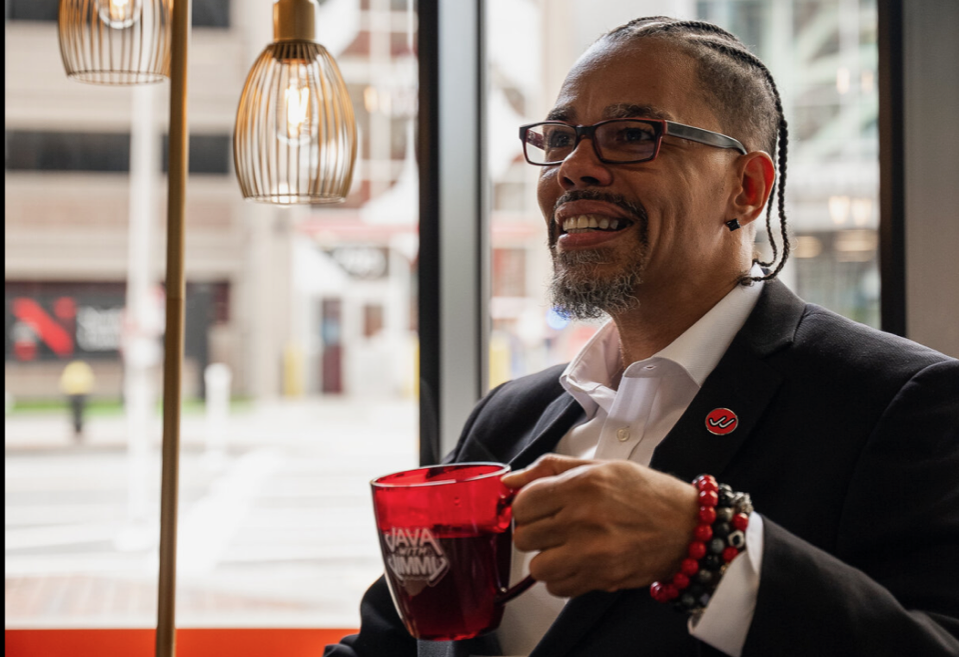The host of ‘Java with Jimmy’ on how a quarantine hobby became a community-based career
In a slew of mainstream media, it can be difficult to find a voice that feels familiar and genuine, like a conversation with a next-door neighbor.
For James “Jimmy” Hills, the host of “Java with Jimmy,” creating an impact while maintaining authenticity is crucial to his brand and ethos. When Hills went live on Instagram one day during quarantine, he had no expectation of the career change that was to follow. Hills pivoted from work in government and medicine to being a full-time journalist.
Receiving the title of “Boston’s #1 community driven platform,” community impact is still at the center of his work. Hills was named one of Boston Magazine’s most influential Bostonians in 2023. Interviewing household names like Gov. Maura Healey and Mayor Michelle Wu to health experts and everyday Bostonians, Hills discusses relevant issues in a conversational, digestible fashion to appeal to his audience. “Java with Jimmy” airs Monday through Thursday at 9 a.m.

Storybench spoke with Hills to understand his content strategy, why the medium he operates in is effective and how upcoming changes to the format will impact the future of the show.
The following interview has been edited for clarity and length.
How did “Java with Jimmy” begin?
Hills: “Java with Jimmy” began on March 24, 2020, the day the governor told us we needed to stay home, at that time for what we thought was weeks or a couple of months at most. I had a social media following, active in the community, you know, had been an activist throughout the years, and I went live that one day. This was not an intentional thing. I had a following, so I was used to 20 to 30 people on my [Instagram live broadcasts].
This particular morning, like 50 people came on. And at the very end, my mother typed in the comments, “Will this be an everyday coffee hour?” And I was like, I didn’t plan on it. But in that moment, I committed that I would be there every day until this thing was over. Thinking this would be two weeks, two months; but low and behold, three and a half years later, we’re still here.
How do you think the format of the show influences the audience and the content?
One of the things that I think is attractive is I am as authentic and as organic as possible since when we started. I come from a faith-based background, I worked in government and community and I’ve worked in medicine.
The authenticity and the organic [nature] of the space is that I could go from cussing about what Trump is doing, to somebody [who] types in the comments and says, “Well my aunt just died, can you pray for me?” and I would take my hat off and we’d have a prayer. And then we’d go into, I don’t know, some comedic video that was circulating on the internet. People are tired of mainstream media, and they want something different; more community-based, more individual- and more internet- based.
My mission is to inform and educate the community for the purpose of mobilizing action, to bring us all to an equitable quality of life, and mainly for the most marginalized communities. It’s about bringing information and education, and saying, not only the information in layman’s terms, but presenting the presenter as a human.
Have you seen a steady increase in viewer engagement?
For about a year, my numbers were very strong on [Instagram] live. My numbers were also strong on what I call the “Afterwatch,” where I leave the episodes up on Twitter, Facebook and YouTube. Those numbers were, at one point, not as strong because people were watching in real time.
As people went back to work, keeping the same type of audience was difficult. You know, I have a core audience that I refer to, and it’s more than them, but I refer to them as the “Mother’s Board.” They are about maybe nine or ten women who are seniors, and no matter if nobody else comes in in the morning, they’re on.
I average now on daily, probably about 20 to 25 people. But, now that I have a team, they kind of are like, “You’re gonna need to adapt.” My social media is growing like crazy.

What does the future of “Java with Jimmy” look like?
I’ll be very honest with you, I want to syndicate. I want to be a platform that goes beyond just “Jimmy.” I want to offer young people, I want to offer that aspiring poet or storyteller, I want to offer that young DJ — I want to offer them opportunities and create a platform that is very unique and community-based that moves in a space of information sharing.
There could be music, there could be different types of interviews, and also I want to help build other personalities. I want to expand the platform and just increase my impact. The foundation of everything — in the future, the present and the foundation of the past — is impact. I’ve told people, I would shut this thing down if I realized that I’m just sitting up here talking head, and I’m not having an impact.





